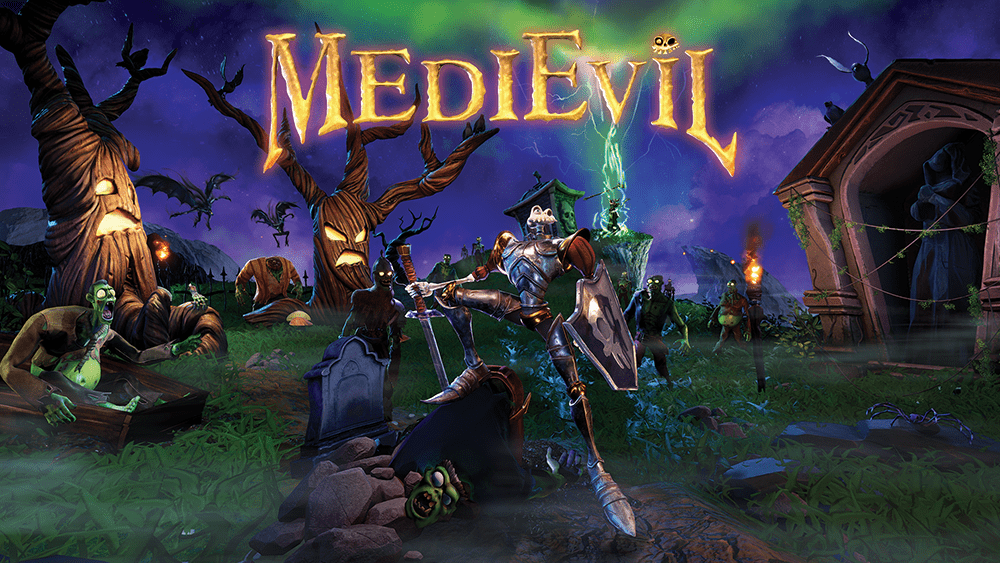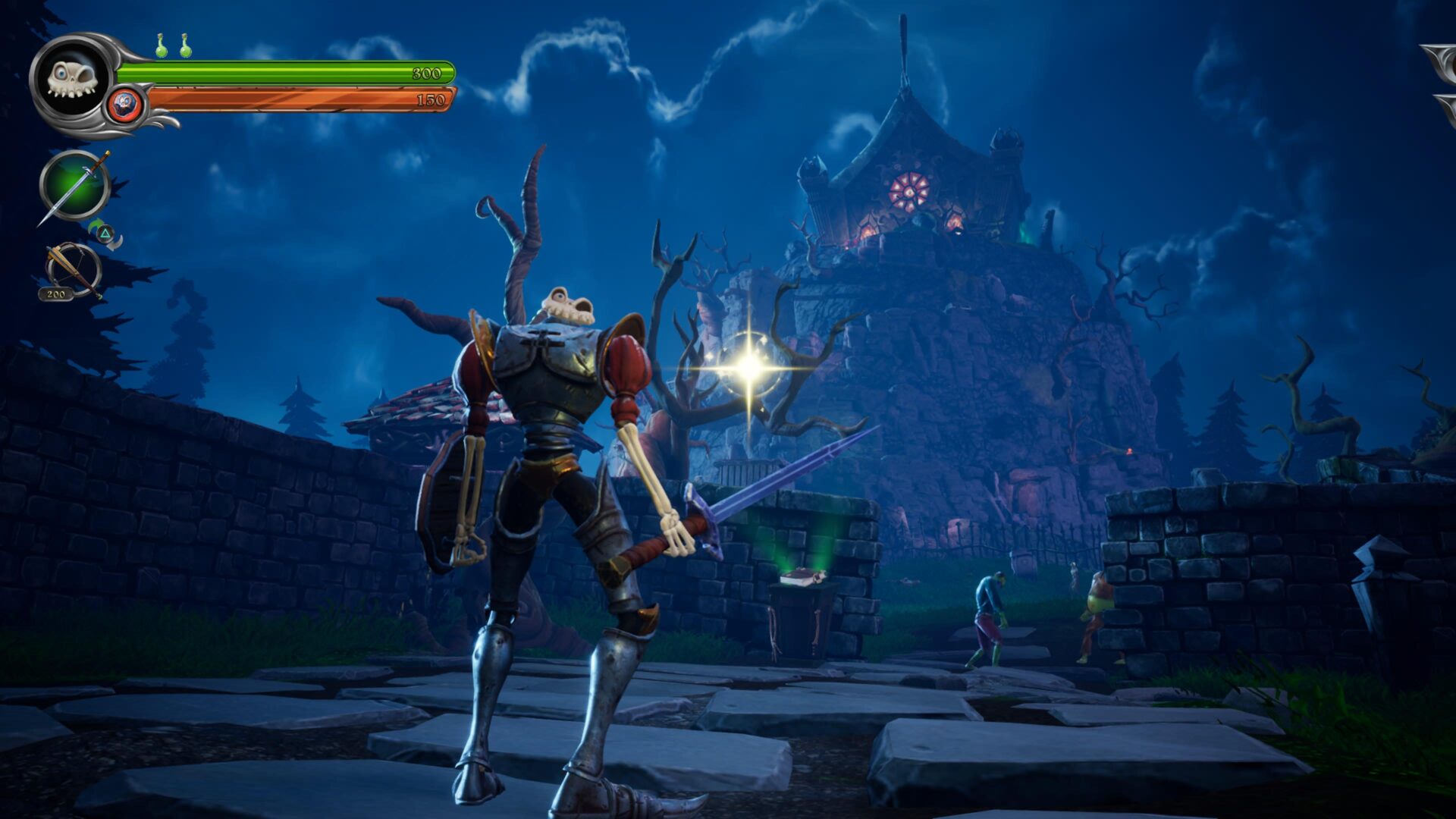Do you start a game like Doom for the frantic shooter action, but stay for that sweet, sweet, colored key collection? Do you pine for the inventory-based puzzles of the point-and-click adventures of yesteryear, but also appreciate the fine art of wanton button-mashing? Do you want a game that’s full of Halloween flavor sans the tension of dodging an ever growing legion of shambling zombies?
If so, MediEvil might be the game for you.

Originally released for the PS1 in 1998, but more recently rereleased for the PS4 in 2019, MediEvil recounts the legend of Sir Daniel Fortesque: the hero of Gallowmere, vanquisher of demons, and possessor of the twinkliest teeth. The valiant Sir Dan earned his fame by leading the charge against the evil sorcerer Zarok, who sought to dominate the land of Gallowmere with his monstrous hordes. Though he was assumed to have been utterly destroyed by Fortesque, 100 years after Sir Dan’s campaign, Zarok returns to resurrect his minions and once more terrorize the land.
Zarok’s spell works perhaps a bit too well, though, and also brings Sir Dan back from the dead. It’s at this point you assume the role of the now-skeletal sir, who wakes up and recalls the moment of his death. As it turns out, the legend of Sir Dan had grown a bit in the telling. Fortesque was indeed on the frontlines against Zarok’s army, but his participation in the charge was forever cut short after a rather pointed disagreement with an enemy archer. Consequently, Sir Dan is motivated as much by a desire to live up to his accidental fame as he is by a desire to save Gallowmere and defeat Zarok once and for all. It’s a well-paced and charming tale, and if he had either of them, one could imagine Sir Dan’s tongue planted firmly in his cheek throughout.
At first, MediEvil presents itself as a fairly basic hack ‘n’ slash. Sir Dan can equip two weapons at a time, each assigned to a face button. Basic attacks are achieved by pressing said button, or you may hold the button to perform a charged attack. That’s pretty much the extent of combat, and while you will earn a decent assortment of weapons in the course of the adventure, the differences between melee and ranged weaponry are largely cosmetic. (Some weapons will interact with the environment in special ways for non-combat purposes.) The combat, therefore, isn’t incredibly deep, but it also isn’t the main attraction: rather, it is but one component in a unique concoction of gameplay mechanisms that works surprisingly well.

MediEvil‘s informal quests and puzzles are really what put meat on its bones. Each level shares the foundation of a set of areas partitioned by locked gates that can be opened with matching keys hidden within. However, after the tutorial missions, each level presents a unique hook that forces you to approach the game slightly differently. Often these involve satisfying the requests of Gallowmere’s quirky denizens, which could be as simple as handing over the right item, or saving particular NPCs from danger. No matter the circumstances, MediEvil presents these challenges with cartoonish charm and cheeky humor.
Each level has also has a hidden chalice that can be obtained once you’ve defeated enough enemies. Enemies do not respawn, however, and many are hidden off the beaten path. Therefore, obtaining chalices becomes a puzzle in itself that can require repetition of a given mission. They’re purely optional, but the rewards are well worth the effort. If you complete a level after having obtained its chalice, you’re whisked to the Hall of Heroes, where you’ll earn a new weapon for Sir Dan. The new weapons may not add much complexity to the combat mechanics, but it is helpful to have multiple iterations of the ranged weapons in particular, since that effectively increases the amount of ammo you can carry.
Sir Dan progresses through the land of Gallowmere by means of MediEvil‘s overworld map, which charts your progress and occasionally offers you branching paths on the way to Zarok’s lair. While the individual levels are self-contained, items you obtain stay with you and may be relevant several missions later, or vice versa, and may also in some circumstances be combined or interact with the environment. Therefore, you’re always encouraged to be observant both to your surroundings and to the item descriptions so you’re never far from a solution. The puzzles may not be as complex as something you’d see in The Longest Journey or Primordia, but that point-and-click influence is there and the answers are not spoon-fed, so it ends up being a satisfying experience.
From a presentation perspective, MediEvil has been updated for the HD era, but it still can’t quite hide its age. There’s a handful of interactable elements in the environment – haystacks in a couple levels come to mind – that would seem more at home on the PS2 than in a PS4 game. Since the world itself and the character models generally look polished and work well to evoke the spooky cartoon theme, these few abnormalities are particularly jarring. Perhaps those instances are deliberate choices so as not to depart from the appearance of the original, or result from a deeper architectural/technical constraint, but either way levelling nitpicky graphical criticisms seems silly to me. MediEvil‘s not striving for breathtaking graphical fidelity, it’s a lighthearted romp of a Halloween fairy-tale, and from that perspective it looks great. As for the music – while I can’t recall any specific themes, I always felt like the soundtrack matched the ambience, particularly through its instrumentation.
While there were certain graphical elements or occasional frustrating platforming sections that seemed dated, MediEvil‘s sense of humor and lack of pretension gave me the sense that the game was a labor of love. Its unique blend of mechanics was a pleasant surprise, and while its individual elements might seem meager on their own, MediEvil ends up being more than the sum of its parts.
Overall Score:
Graphics: 7 / 10
Gameplay: 7 / 10
Charm: 10 / 10
Morality/Parental Warnings
In general, MediEvil seemed pretty tame to me. There’s a little bit of mild ribaldry in interactions with one of the Hall’s heroes, and some can be found in the game’s codex entries. The villain’s army is obviously composed of the reanimated dead and various demons, but everything is presented with a cartoony aesthetic.
Spiritual Value
Underneath MediEvil‘s goofy exterior is a pleasingly resonant tale of redemption. Sir Dan is a universally relatable character: we all want to be like the Fortesque of legend, but we know we’ve got more in common with the Fortesque of reality. And just like Sir Dan, our path to redemption comes after we experience a death and rebirth of our own. As St. Paul writes, “We were buried therefore with him by baptism into death, so that as Christ was raised from the dead by the glory of the Father, we too might walk in newness of life.” (Rom 6:4) Its tale might be be humerus humorous, but in a small way it can remind us of the gift of our baptism, and inspire us to cooperate with God’s grace. Only in doing so can we grow into the heroic figure we wish we were, and God knows we can be.
